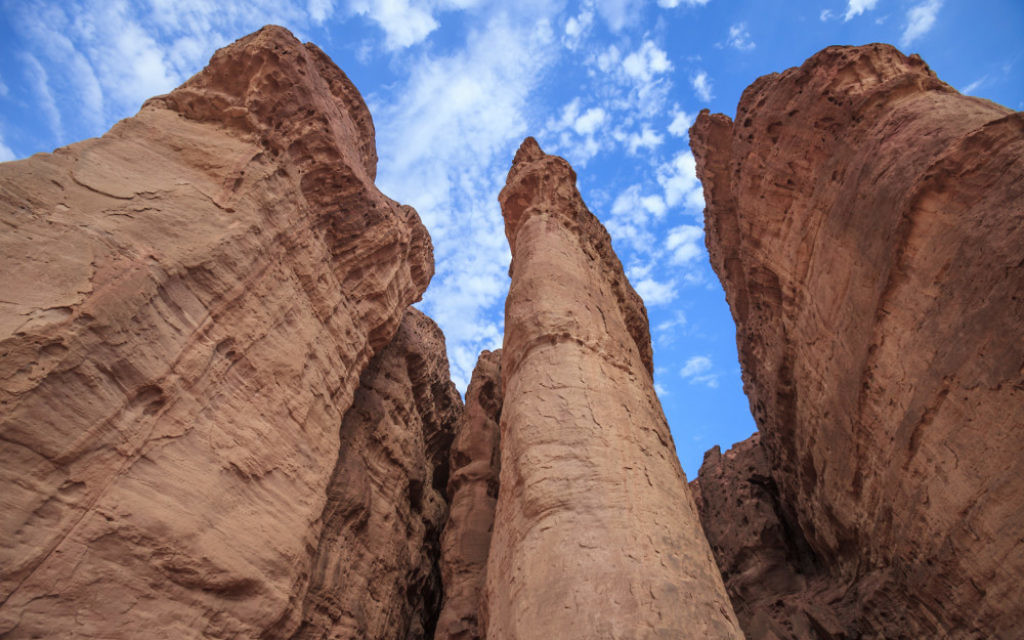Trekking Into Soul of Israel National Trail
Udi Goren hit a low point in 2014, but his legs lifted him onto the path to success.
He was struggling financially and feeling frustrated professionally as he tried to establish himself as a freelance photographer in Tel Aviv. Then the war in Gaza broke out, fueling a frenzy in traditional and social media.

“I felt that Israel was going into another round of violence and division, and it just was too much for me to handle,” Goren said.
Get The AJT Newsletter by email and never miss our top stories Free Sign Up
But instead of following his tendency to pack up and leave — he spent six years traveling, studying and living abroad after finishing his Israel Defense Forces service — he decided to turn inward and do something he twice started in 2007 but abandoned: walk the entire Israel National Trail, running more than 620 miles from Kibbutz Dan on the Lebanese border in the northeast to Eilat on the Red Sea in the south.
“I left the country of Israel and went to travel the land of Israel,” said Goren, who became the first professional still photographer to walk the entire trail in one trip.
“It’s very powerful to tread every mile of where you live,” he said in a phone interview.
That life-changing 2½-month physical and spiritual journey opened his eyes to the beauty and soul of his own land and gave his professional life direction with “my first big passion project in Israel.” It’s a project with many phases, including, he hopes, the first coffee-table book documenting the trail.
He’ll be sharing that passion during a month-and-half fall speaking tour of the United States, his second U.S. trip this year. He will start at the University of Florida Hillel on Oct. 26, then move north and west.
Visit his website, www.israeltrailtalk.com, to keep up with tour dates or to book him for a school, synagogue or other group, whether to speak about the trail, set up an exhibit of his photos or lead a workshop on seeing your world through the eyes of a photographer.

It might be a cliché to say Goren truly saw his Israeli world for the first time during his walk along the trail. After all, he has been a hiker his whole life, and his parents took him to explore the natural side of Israel when he was a boy.
“But it’s very different when you’re outdoors for 2½ months than when you wake up one Saturday, drive the car, hike in the Galilee, then drive home,” he said.
This journey was the first time he got to see and experience all of his country — all facets and all factions of a society that so often seems permanently divided. The political entity is the place facing daily friction, but “when I talk about the land, I talk about the physical place, the actual people that I’ve met personally and seeing the landscapes for myself, treading the mountains and the beaches and seeing the wildlife and the historic sites along the way.”
He said an archaeological site near Be’er Sheva illustrates the difference between learning the history and geology of Israel and experiencing it. It’s one thing to drive there in air conditioning, look around for an hour and drive away and another to come upon this place people have lived for 4,000 years after walking through the desert with sweat pouring out of you for half a day.
That ground-level view of Israel connects with people in a nonpolitical way, Goren said. “Talking about the land is actually the reason that people care about Israel, about this place and the people, our mutual heritage and mutual history. It gives people an opportunity to connect.”
In addition to rekindling people’s passion for Israel, Goren said he hopes his presentations spark a sense of adventure so that people will venture outside the standard tourist haunts in Jerusalem and Tel Aviv. “You get to experience the place in a very different way.”
Walking the Trail
The Israel National Trail has one major advantage and one major disadvantage, Udi Goren says.
The advantage is that the trail is small, well-mapped-out and can be broken up into easy segments. So even though only about 300 people a year walk the full length, going south to north in spring or north to south in the fall, “you can go in and out pretty much every day,” Goren said.
You can carry a tent and camp out anywhere along the trail, or you can leave the trail to get lodging at night. There also are trail angels who, with notice of a day or two, will let you stay the night with them free.
But the ease of supply and logistics lasts only until you get to Arad, which is east of Be’er Sheva on the northern edge of the Negev. The desert portion is tough, Goren said, and you have to plan for your water and food. You can arrange for deliveries at certain points, or you can bury supplies in advance, which is what he did in 2014.
Photos by Udi Goren







comments